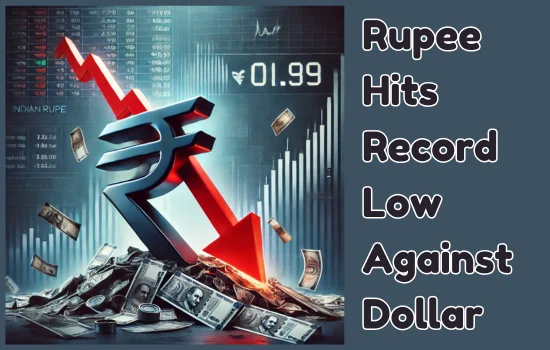The Indian rupee fell to an all-time low of 86.69 against the US dollar on Monday, driven by a surge in demand for the greenback from oil importers and ongoing global economic pressures. This significant depreciation of the rupee underscores the challenges India faces as it grapples with volatile crude oil prices, a widening trade deficit, and tightening global monetary policies.
Key Drivers Behind the Slide
- Increased Dollar Demand by Oil Importers:
- India, the world’s third-largest importer of crude oil, relies heavily on dollar-denominated imports to meet its energy needs. The rise in global crude oil prices has significantly increased the demand for dollars, putting downward pressure on the rupee.
- With Brent crude hovering around $85 per barrel, oil importers have ramped up their purchases, exacerbating the rupee’s fall.
- Global Dollar Strength:
- The US dollar remains strong globally, bolstered by the Federal Reserve’s hawkish stance on interest rates. Higher interest rates in the US have attracted foreign capital, causing outflows from emerging markets like India.
- The dollar index, which measures the greenback’s strength against a basket of major currencies, remains near multi-month highs.
- Widening Trade Deficit:
- India’s trade deficit widened to $24.5 billion in December 2024, fueled by a surge in imports and weaker export demand. The deficit reflects the growing gap between foreign currency inflows and outflows, further weakening the rupee.
- Foreign Portfolio Outflows:
- Foreign institutional investors (FIIs) have been net sellers in Indian equities and bonds, withdrawing over ₹15,000 crore in January 2025 alone. These outflows have reduced dollar inflows, putting additional pressure on the rupee.
- Geopolitical and Economic Uncertainties:
- Geopolitical tensions, particularly in Europe, and concerns over a global economic slowdown have added to the volatility, pushing investors toward safe-haven assets like the dollar.
Impact on the Indian Economy

The depreciation of the rupee has wide-ranging implications for the Indian economy:
- Rising Import Costs:
- A weaker rupee makes imports more expensive, particularly for crude oil, electronics, and machinery. Higher import bills contribute to inflationary pressures, potentially impacting the purchasing power of consumers.
- Higher Inflation:
- As import costs rise, businesses often pass on the additional expenses to consumers, leading to increased prices for goods and services. India is already grappling with inflation, and a depreciating rupee could exacerbate the situation.
- Corporate Margins:
- Industries dependent on imported raw materials, such as chemicals, pharmaceuticals, and electronics, are likely to see squeezed profit margins due to higher input costs.
- Widening Current Account Deficit (CAD):
- The trade imbalance and higher import costs could widen India’s CAD, which represents the difference between the value of imports and exports. A larger CAD signals increased dependency on foreign capital.
- Tourism and Education:
- For Indian students studying abroad and citizens traveling internationally, a weaker rupee translates to higher expenses, impacting personal finances and travel plans.
- Exporters Gain:
- On the positive side, exporters, particularly in IT and pharmaceuticals, stand to benefit as they earn in dollars and can convert them at higher rupee rates. This could offset some of the broader economic challenges.
Government and RBI Response
The Reserve Bank of India (RBI) has been intervening in the foreign exchange market to stem the rupee’s decline. It has sold dollars from its foreign exchange reserves, which currently stand at $586 billion, to stabilize the currency. However, analysts warn that excessive intervention could deplete reserves and limit the RBI’s capacity to manage future shocks.
The government has also taken steps to attract foreign investments and boost exports, including Production-Linked Incentive (PLI) schemes for manufacturing sectors. However, these measures will take time to yield results.
Market Reaction
The currency market volatility has spilled over to equities and bonds. The benchmark BSE Sensex fell by 0.8% on Monday, as concerns over inflation and foreign outflows rattled investors. The bond market saw yields on 10-year government securities rise to 7.42%, reflecting higher borrowing costs.
What Lies Ahead?
Economists and market experts predict continued volatility in the rupee’s trajectory, with the following factors playing a critical role:
- Crude Oil Prices: Any further spike in oil prices could exacerbate dollar demand, pressuring the rupee further.
- US Federal Reserve Policies: The Fed’s future rate hikes will impact global dollar flows and emerging market currencies, including the rupee.
- Domestic Reforms: Accelerating structural reforms to boost exports, reduce dependency on imports, and attract foreign investments will be key to stabilizing the rupee.
Expert Opinions
“While the rupee’s fall reflects global trends, India’s dependence on energy imports makes it particularly vulnerable. Short-term measures, such as boosting forex reserves and promoting domestic energy production, are crucial,” said an economist at a leading financial institution.
Another analyst highlighted the need for diversification: “India must reduce reliance on fossil fuels and explore alternative energy sources to mitigate the impact of global oil price fluctuations.”
Conclusion
The rupee’s slide to a record low of 86.69 against the dollar underscores the challenges facing India’s economy amid global uncertainties and domestic vulnerabilities. While the depreciation poses risks such as inflation and higher import costs, it also offers opportunities for export-driven sectors to thrive.
Moving forward, the government and RBI will need to strike a delicate balance between stabilizing the rupee and supporting economic growth, ensuring India remains resilient in a volatile global environment. For businesses and individuals, the focus must be on adapting to these changing dynamics while planning for a more stable economic future.

Hello, I’m Kapil Kumar, a seasoned SEO expert and blogger at WinnersList.in. My mission is to spotlight exceptional individuals and organizations across various domains. Through curated lists, profiles, and inspiring stories, I aim to celebrate outstanding achievements and inspire the next generation of champions. Join me in this journey.
